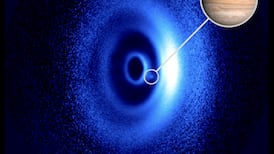Mars once had a large ocean of water, some parts of it more than a kilometre and a half deep. But most of this was lost into space leaving Mars the desert we see today, according to research from the US National Aeronautics and Space Administration.
The scientists believe it could have contained 20 million cubic kilometres of water, about the volume of the Arctic Ocean. But 87 per cent of this evaporated and drifted off the planet over the past billion years or so.
What remains is held as ice mainly at the planet’s poles and probably under parts of the arid Martian surface.
"Our study provides a solid estimate of how much water Mars once had by determining how much water was lost to space," said Geronimo Villanueva, first author of a paper published in the journal Science.
If Mars were a perfectly smooth ball this much water would have covered the whole planet to a depth of 137 metres. But it is not smooth and the water would have accumulated in a large low spot, which on Mars means the great northern plains, the scientists say.
The resulting ocean would have covered half of the planet’s northern hemisphere, in some places to a considerable depth.
Obviously the scientists based at the Goddard Space Flight Centre in Maryland had no visual record to make their prediction, they had to calculate it in a round-about way by looking at the ratio of two kinds of water molecule.
HDO
Ordinary water, H20, has one oxygen and two hydrogen atoms, but there is a variant of this, HDO, made up of one oxygen, one hydrogen and one heavy hydrogen known as deuterium.
The project saw three huge earth-bound telescopes called into play at the Keck Observatory and Nasa’s Infrared Telescope Facility, both in Hawaii, and the European Space Agency’s Very Large Telescope in Chile.
These scanned the planet over three years, detecting the small amounts of H2O and HDO in the atmosphere that remain, particularly near the poles but in unexpected locations as well.
As water was gradually lost the ratio of H2O to HDO changed, causing an “enrichment” of the water that remained. This allowed the scientists to predict the amount of water that went, based on the amount of enriched water that remains.
This is not just about the numbers. With that much water about “the planet was very likely wet for a longer period of time than was previously thought suggesting the planet might have been habitable for longer”, says Michael Mumma, the second author on the paper.
This increases the possibility of finding signs of previous life on Mars. And the “hot spots” where atmospheric water was detected may pinpoint hidden underground water.











